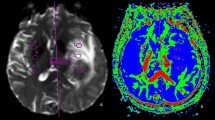Abstract
Background
Metastatic brain tumors from gastric and colon cancers are frequently revealed by hypointensity on T2-weighted magnetic resonance images (MRIs). However, the reason for this T2 hypointensity has yet to be clarified. We hypothesize that it is due to collagen deposition within the tissues.
Methods
Seven metastatic brain tumors, from 3 gastric cancers and 4 colon cancers were investigated. The degree of hypointensity of these tumors in T2-weighted images was quantitatively assessed as the ratio of gray-scale densities of tumor to brain using ImageJ. The result was compared with the amount of collagen in the resected specimens, which was quantified by ImageJ analysis software, utilizing the colour deconvolution method following Azan-Mallory staining. The degree of hypointensity was also compared with the ratio of viable epithelial component area/whole tissue area. Additionally, collagen distribution was studied by immunohistochemical staining.
Results
There was a clear negative correlation between intensity in T2-weighted images of these metastatic tumors and the amount of collagen they contained (R 2 = 0.766). However, there was no significant correlation between the T2 intensity and the ratio of viable epithelial component. Immunohistochemical analysis revealed that collagen types I, III, VII, X, and XI were expressed in the epithelial components and types IV, V, and VI were expressed in the stromal areas of the metastatic tumors. Collagen deposition was observed not only in stromal fibrous areas, but also in cytoplasmic areas in these metastatic tumors.
Conclusions
Hypointensity of metastatic brain tumors arising from gastric and colonic cancers may be due to the accumulation of collagen in the tissues.




Similar content being viewed by others
References
Murakami R, Korogi Y, Sakamoto Y et al (1995) Skull metastasis from hepatocellular carcinoma. CT, MR and angiographic findings. Acta Radiol 36:597–602
Zhang S, Wang M, Xue YH et al (2007) Cerebral metastasis from hepatoid adenocarcinoma of the stomach. World J Gastroenterol 13:5787–5793
Kanai H, Yamada K, Aihara N et al (2000) Pineal region metastasis appearing as hypointensity on T2-weighted magnetic resonance imaging—case report. Neurol Med Chir (Tokyo) 40:283–286
Oshiro S, Tsugu H, Komatsu F et al (2008) Metastatic adenocarcinoma in the brain: magnetic resonance imaging with pathological correlations to mucin content. Anticancer Res 28:407–413
Brown G, Radcliffe AG, Newcombe RG et al (2003) Preoperative assessment of prognostic factors in rectal cancer using high-resolution magnetic resonance imaging. Br J Surg 90:355–364
Kim IY, Kim SW, Shin HC et al (2009) MRI of gastric carcinoma: results of T and N-staging in an in vitro study. World J Gastroenterol 15:3992–3998
Ruifrok AC, Johnston DA (2001) Quantification of histochemical staining by color deconvolution. Anal Quant Cytol Histol 23:291–299
Suzuki M, Takashima T, Kadoya M et al (1993) Signal intensity of brain metastases on T2-weighted images: specificity for metastases from colonic cancers. Neurochirurgia (Stuttg) 36:151–155
Egelhoff JC, Ross JS, Modic MT et al (1992) MR imaging of metastatic GI adenocarcinoma in brain. AJNR Am J Neuroradiol 13:1221–1224
Carrier DA, Mawad ME, Kirkpatrick JB et al (1994) Metastatic adenocarcinoma to the brain: MR with pathologic correlation. AJNR Am J Neuroradiol 15:155–159
Iuchi T, Saeki N, Tanaka M et al (1998) MRI prediction of fibrous pituitary adenomas. Acta Neurochir (Wien) 140:779–786
Liu HQ, Yin X, Li Y et al (2012) MRI features in children with desmoplastic medulloblastoma. J Clin Neurosci 19:281–285
Naito Y, Kino I, Horiuchi K et al (1984) Promotion of collagen production by human fibroblasts with gastric cancer cells in vitro. Virchows Arch B Cell Pathol Incl Mol Pathol 46:145–154
Korenaga D, Orita H, Maekawa S et al (1998) Peritoneal collagen type IV concentration in adenocarcinoma of the gastrointestinal tract and its relationship to histological differentiation, metastasis, and survival. Surg Today 28:780–786
Ohno S, Tachibana M, Fujii T et al (2002) Role of stromal collagen in immunomodulation and prognosis of advanced gastric carcinoma. Int J Cancer 97:770–774
Coulson-Thomas VJ, Coulson-Thomas YM, Gesteira TF et al (2011) Colorectal cancer desmoplastic reaction up-regulates collagen synthesis and restricts cancer cell invasion. Cell Tissue Res 346:223–236
Grefte S, Kuijpers-Jagtman AM, Torensma R et al (2010) Skeletal muscle fibrosis: the effect of stromal-derived factor-1α-loaded collagen scaffolds. Regen Med 5:737–747
Pini A, Shemesh R, Samuel CS et al (2010) Prevention of bleomycin-induced pulmonary fibrosis by a novel antifibrotic peptide with relaxin-like activity. J Pharmacol Exp Ther 335:589–599
Correa GAR, Zacchigna S, Arsic N et al (2004) Potent inhibition of arterial intimal hyperplasia by TIMP1 gene transfer using AAV vectors. Mol Ther 9:876–884
Kadonishi Y, Deie M, Takata T et al (2012) Acceleration of tendon-bone healing in anterior cruciate ligament reconstruction using an enamel matrix derivative in a rat model. J Bone Jt Surg Br 94:205–209
Yin Y, Zhao Y, Li AQ et al (2009) Collagen: a possible prediction mark for gastric cancer. Med Hypotheses 72:163–165
Conflict of interest
The all authors declare that they have no conflict of interest.
Ethical standard
This retrospective study was endorsed by the ethical committee on clinical research at Kagoshima University Graduate School (No. 22-50 in 2010).
Author information
Authors and Affiliations
Corresponding author
About this article
Cite this article
Hirano, H., Yokoyama, S., Yunoue, S. et al. MRI T2 hypointensity of metastatic brain tumors from gastric and colonic cancers. Int J Clin Oncol 19, 643–648 (2014). https://doi.org/10.1007/s10147-013-0596-8
Received:
Accepted:
Published:
Issue Date:
DOI: https://doi.org/10.1007/s10147-013-0596-8




